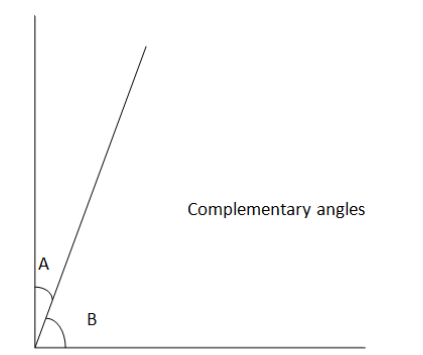
The angle which is one fifth of its complement is:
\[
A.{\text{ }}{15^0} \\
B.{\text{ }}{30^0} \\
C.{\text{ }}{45^0} \\
D.{\text{ }}{60^0} \\
\]
Answer
573.9k+ views
Hint: In order to solve this problem first we have to look for the meaning of complementary angles. We will consider one of the complementary angles in terms of some unknown variable and with the help of that variable first we have to write an equation according to the question statement and then we have to solve it to get the value of angle.
Complete step by step answer:

In the above given figure the angle A and angle B are complementary angles as they combine to for 90 degrees.
Finding out angle which is $\dfrac{1}{5}$ of its complement
Let us take angle as x degree
Then we can write its complement as = (90 - x) degree
According to the question statement we have to find an angle which is equal to its one fifth complement.
By writing it in mathematical way
$x = \dfrac{1}{5} \times \left( {90 - x} \right)$
By cross multiplication we get
$5x = 90 - x$
Further solving it
$ \Rightarrow 5x + x = 90 \\
\Rightarrow 6x = 90 \\
\Rightarrow x = \dfrac{{90}}{6} \\
\Rightarrow x = 15 \\ $
So that the value of $x = {15^0}$
So, the correct answer is “Option A”.
Note: The complement is the amount you must add to something to make it "whole". For example, in geometry, two angles are said to be complementary when they add up to ${90^0}$. Like we have to find out the angle which is complement of x would be (90-x).
Complete step by step answer:

In the above given figure the angle A and angle B are complementary angles as they combine to for 90 degrees.
Finding out angle which is $\dfrac{1}{5}$ of its complement
Let us take angle as x degree
Then we can write its complement as = (90 - x) degree
According to the question statement we have to find an angle which is equal to its one fifth complement.
By writing it in mathematical way
$x = \dfrac{1}{5} \times \left( {90 - x} \right)$
By cross multiplication we get
$5x = 90 - x$
Further solving it
$ \Rightarrow 5x + x = 90 \\
\Rightarrow 6x = 90 \\
\Rightarrow x = \dfrac{{90}}{6} \\
\Rightarrow x = 15 \\ $
So that the value of $x = {15^0}$
So, the correct answer is “Option A”.
Note: The complement is the amount you must add to something to make it "whole". For example, in geometry, two angles are said to be complementary when they add up to ${90^0}$. Like we have to find out the angle which is complement of x would be (90-x).
Recently Updated Pages
Master Class 9 General Knowledge: Engaging Questions & Answers for Success

Master Class 9 English: Engaging Questions & Answers for Success

Master Class 9 Science: Engaging Questions & Answers for Success

Class 9 Question and Answer - Your Ultimate Solutions Guide

Master Class 12 Economics: Engaging Questions & Answers for Success

Master Class 12 Maths: Engaging Questions & Answers for Success

Trending doubts
Which places in India experience sunrise first and class 9 social science CBSE

Fill the blanks with the suitable prepositions 1 The class 9 english CBSE

Write the 6 fundamental rights of India and explain in detail

Difference Between Plant Cell and Animal Cell

What is pollution? How many types of pollution? Define it

What is the Full Form of ISI and RAW




